MATHS COURSEWORK:
THE FENCING PROBLEM
We are told that a farmer has exactly 1000 metres of fencing with which she wishes to fence off a plot of land. The shape of the fence does not concern her; however, what she does wish to do is fence off the plot of land, which contains the maximum area. Therefore, the point of this investigation is to investigate the shape, or shapes of the plot of land that have the maximum area.
Starting with rectangles, any 2 different length sides will add up to 500, because each side has an opposite with the same length. Therefore, in a rectangle of 100m X 400m, there are two sides opposite each other that are 100m long and two sides next to them that are opposite each other that are 400m long. This means that you can work out the area if you only have the length of one side. Here are four types of squares or rectangles that all have the same perimeter but a difference in area. NOT DRAWN TO SCALE:
To work out the area of a rectangle with a width length of 150m I would subtract 150m from 500m, which would then leave me with 350m, and then I would multiply 150m by 350m giving me a total area of 52 500m2. From this evidence, I can put this into an equation. The equation to work out a rectangle is, 1000 = width (500 –width). By using the equation, you can make a prediction table.
From analysing the graph and the table, it shows that the biggest rectangle is with a length of 250m and a width of 250m. This shape is a square, a regular quadrilateral. As I recorded the results to the nearest 10m, I am not entirely certain that the table and graph I produced are correct, so I will now work out the results using the lengths against the area between the two lines on the previous page. This will prove if all the results will fit on the line graph.
This is because as the height decrease the area decreases so turning a rectangle into a parallelogram will decrease in area. Now that I have found that a square has the greatest area out of the rectangles group, I will now find the type of triangle, which has the greatest area.
If an isosceles triangle was tilted left or right like shown in the diagram above it would turn into a scalene triangle, with different angles but would still have the same area as the base stays the same. So since a regular square was the biggest in area out of the rectangles, I predict that the biggest area will belong to the equilateral triangle. I will try isosceles triangles because I can vary the base easily with this. If I know the base length, I can then work out the other two lengths, because they are the same.
E.g. if the base of the triangle was 200m long then I could subtract 200 from a thousand leaving me with 800m left and then I could divide 800 by 2 leaving me with 400m for each of the unknown lengths. Using a formula for this could be a lot simpler. Side=(1000-200) ÷ 2=400
I will need the height of a triangle to be able to work out the area and to find this I will need a formula or some sort of equation. This can be used using Pythagoras rule. Below is the formula and area of an isosceles triangle when using the base of 200m.







